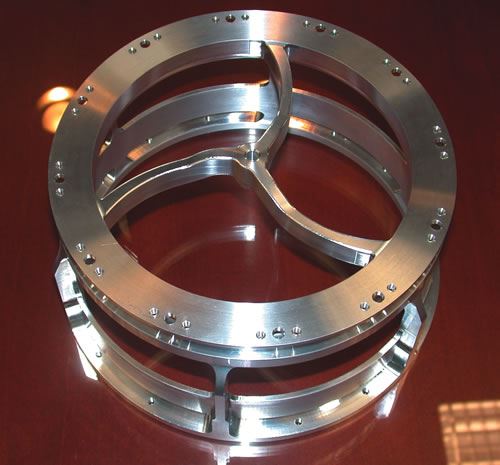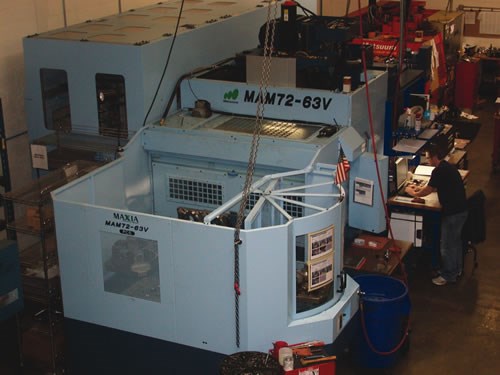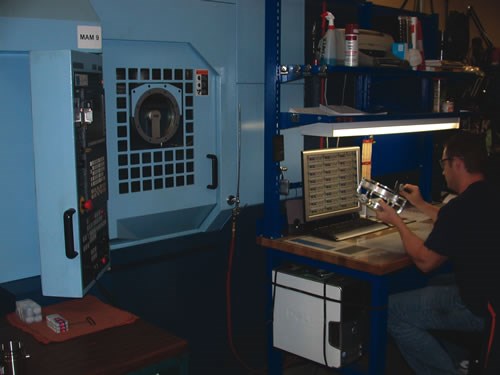Shop Reduces Setup Time With Multi-Pallet Machines
Automated, lights-out production has enabled this manufacturer to take on a large number of low-volume jobs for various industries. With a wide variety of work, minimizing setup times is key to the shop’s success. Multi-pallet, four- and five-axis Matsuura machines supplied by Methods Machine Tools have enabled the shop to not only keep setup times low, but also meet customer demand for nearly error-free production runs.
Share





When George McNab, president of MAC Machine Company, says his shop has "always been a proponent of automation," he’s not exaggerating. The Baltimore, Maryland-based company first began running multi-pallet, horizontal milling machines unattended 22 years ago, a time when few manufacturers had implemented "lights-out" production. For MAC, it was the beginning of a specialization in short-run, high-mix production in which setup time is often a make-or-break factor in meeting deliveries and making profits.
To minimize setup time, the company relies on Matsuura four- and five-axis, multi-pallet VMCs and HMCs supplied by Methods Machine Tools of Sudbury, Massachussets, the exclusive North American Matsuura importer. These machines have increased the shop’s competitiveness to the point where it can successfully participate in all markets to which it is exposed, Mr. McNab says.
Those markets include aerospace, defense and medical, which account for approximately 60, 20 and 15 percent of the company’s work, respectively. The remainder of the work is for high-technology, commercial customers. Among the components produced at the shop are mechanical parts used in space suits and components for the Joint Strike Fighter, as well as items for submarines, missiles, rocket motors and ejector seats. Other work includes surgical implants and components for diagnostic medicine, commercial satellites and aircraft. While most production is for the domestic market, the company also attracts business from Europe, the Middle East and other regions.
The production floor is a busy place, with more than 200 active projects at any given time, Mr. McNab says. And high-quality machines aren’t the only important factor in meeting the demands of a lights-out production process—this also requires a skilled workforce, he adds. The company depends on specialized "setup machinists" who work the first shift to prepare new work for the multi-pallet production line. The second shift is much smaller, consisting of only seven or eight of the shop’s 60 total employees. These workers are charged with monitoring the automated systems and ensuring everything is in order for the unattended third shift.
The shop runs unattended 90 hours per week out of an available 168 production hours. Prior to its switch to multi-pallet systems, the shop used single- and twin-spindle vertical machines that required lengthy setup times and were not suitable for unattended operation. The transition to multi-pallet machining centers eliminated more than 50 percent of previously required operations by enabling complete machining of a part in a single cycle, Mr. McNab says. He credits Methods, which supplied the company’s first Matsuuras nearly 25 years ago, for continually providing the equipment, expertise, programming assistance and support needed to make unattended production work.
Using multi-pallet machines to reduce setup times on small production lots has since become a core competency for MAC Machine, and the company has earned a reputation for taking on difficult jobs that other shops might decline. While that has created strong customer relationships, it has also consistently led to a demand for smaller lots, lower pricing and zero tolerance for error. "We must anticipate problems in advance and take corrective action before the green button is pushed," Mr. McNab says. "We have to make good parts right the first time."
Thanks in part to its skilled workforce and a climate-controlled quality lab, the company manages to achieve a percent parts-per-million (ppm) rate of less than 1,000. That is, on a job consisting of 1,000 parts, only one will be rejected. However, Mr. McNab emphasizes that achieving near-perfect production runs and addressing cost and delivery concerns make up only part of the equation—productivity is the most challenging aspect of meeting stringent customer expectations. And with throughput limited by machining speed, improving productivity comes down to reducing setup times, he says.
For that, the shop depends on its latest Matsuuras: 13 MAM series four- and five-axis machining centers chosen specifically for lights-out production. Among the top performers is the MAM72-63V, a five-axis machine designed for processing large, geometrically complex components within a work envelope that measures 24.8 by 17.7 inches and accommodates workpieces as heavy as 770 pounds. The company also uses the MAM72-35V, a smaller, five-axis model capable of processing workpieces measuring as large as 13.77 inches in diameter and 9.44 inches high. Various H.Plus-300 series HMCs complete the lineup. All are teamed with stand-alone, multi-pallet systems from Matsuura that contain anywhere between 2 and 32 pallets. That means the shop can machine as many as 32 different parts, one right after the other, on a single milling machine.
The configuration of the MAM machines enables the company to automate production of difficult workpieces by virtually eliminating interference areas, Mr. McNab says. Specifically, their fixed spindle and tilting table configuration maximizes the rigidity of the tool and toolholder when milling awkward part features, even when machining irregularly shaped workpieces as large as 24.8 inches in diameter.
The shop also depends on the CAMplete TruePath software furnished with the Matsuuras for bridging the gap between CAM input and the machines. Rather than blindly sending CAM system output through a postprocessor to the machines, the company uses this software to analyze, modify, optimize and simulate five-axis tool paths in a seamless, five-view, 3D environment. This helps avoid problems before pro-duction begins. John Leonard, shop foreman, believes the software has been instrumental in the company’s success with lights-out machining. "Today, an operator can preview the entire routine and anticipate and correct potential issues before any machining even starts," Mr. Leonard says. "This drastically reduces setup times and gives us an invaluable edge over the competition."
Combined with support from Methods, the flexibility and automation capabilities of the Matsuuras have helped streamline MAC Machine’s production process. The multi-pallet systems and CAMplete software have reduced setup times by 85 percent. Additionally, cycle times have been slashed by 70 percent by reducing the number of cycles required to machine a part. However, successfully automating short-run, high-mix jobs has resulted in the greatest savings. "Unattended machining has allowed us to operate second and third shifts with fewer machinists," Mr. McNab says. This has effectively reduced our labor rate by 30 percent and has allowed us to be more competitive."
Related Content
Shoulder Milling Cuts Racing Part's Cycle Time By Over 50%
Pairing a shoulder mill with a five-axis machine has cut costs and cycle times for one of TTI Machine’s parts, enabling it to support a niche racing community.
Read MoreHigh RPM Spindles: 5 Advantages for 5-axis CNC Machines
Explore five crucial ways equipping 5-axis CNC machines with Air Turbine Spindles® can achieve the speeds necessary to overcome manufacturing challenges.
Read MoreWhich Approach to Automation Fits Your CNC Machine Tool?
Choosing the right automation to pair with a CNC machine tool cell means weighing various factors, as this fabrication business has learned well.
Read More6 Machine Shop Essentials to Stay Competitive
If you want to streamline production and be competitive in the industry, you will need far more than a standard three-axis CNC mill or two-axis CNC lathe and a few measuring tools.
Read MoreRead Next
Registration Now Open for the Precision Machining Technology Show (PMTS) 2025
The precision machining industry’s premier event returns to Cleveland, OH, April 1-3.
Read More5 Rules of Thumb for Buying CNC Machine Tools
Use these tips to carefully plan your machine tool purchases and to avoid regretting your decision later.
Read MoreBuilding Out a Foundation for Student Machinists
Autodesk and Haas have teamed up to produce an introductory course for students that covers the basics of CAD, CAM and CNC while providing them with a portfolio part.
Read More


























.jpg;maxWidth=300;quality=90)













